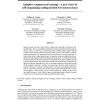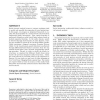499 search results - page 58 / 100 » Learning Through Telemedicine Networks |
ICANN
2003
Springer
14 years 25 days ago
2003
Springer
Abstract. This paper proposes a general approach named ExpectationMiniMax (EMM) for clustering analysis without knowing the cluster number. It describes the contrast function of Ex...
GECCO
2005
Springer
14 years 1 months ago
2005
Springer
Existing Recurrent Neural Networks (RNNs) are limited in their ability to model dynamical systems with nonlinearities and hidden internal states. Here we use our general framework...
ICASSP
2010
IEEE
13 years 7 months ago
2010
IEEE
Sparse coding networks, which utilize unsupervised learning to maximize coding efficiency, have successfully reproduced response properties found in primary visual cortex [1]. Ho...
WCNC
2010
IEEE
2010
IEEE
Hedonic Coalition Formation Games for Secondary Base Station Cooperation in Cognitive Radio Networks
13 years 11 months ago
— In order to maintain a conflict-free environment among licensed primary users (PUs) and unlicensed secondary users (SUs) in cognitive radio networks, providing frequency and g...
ICMI
2010
Springer
13 years 5 months ago
2010
Springer
Social network analysis became a common technique used to model and quantify the properties of social interactions. In this paper, we propose an integrated framework to explore th...



